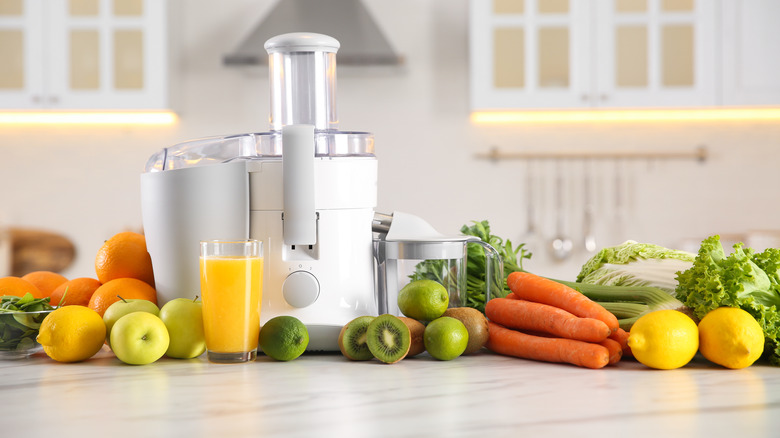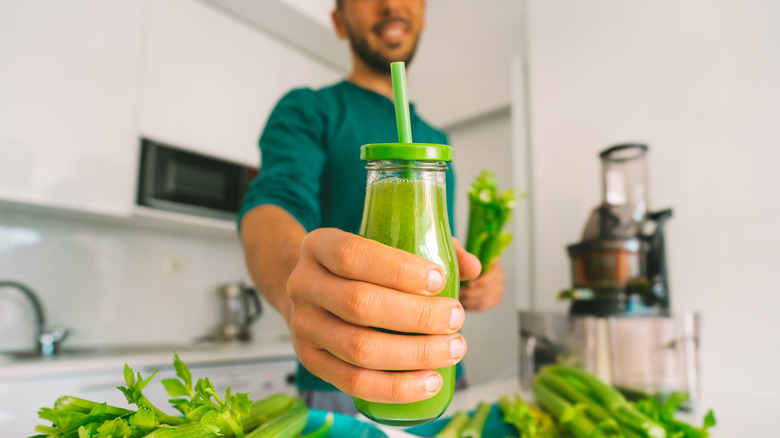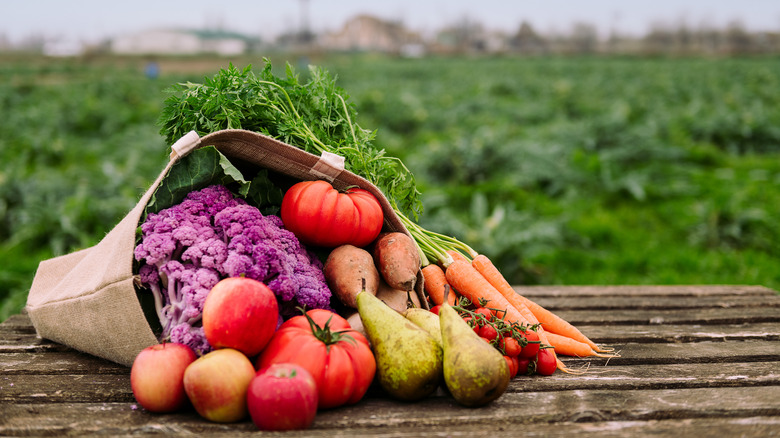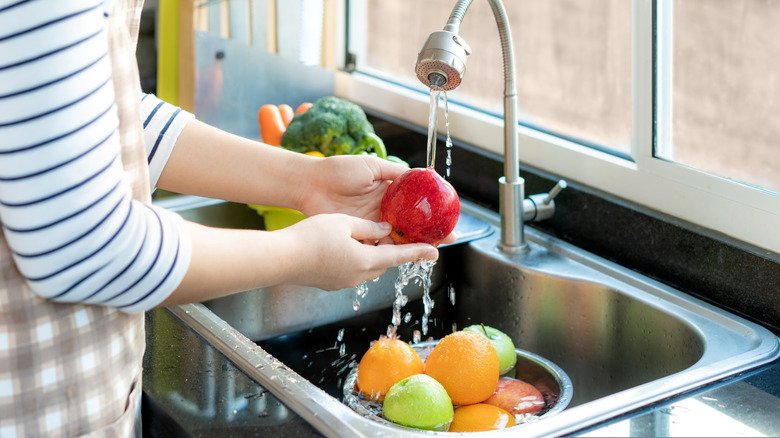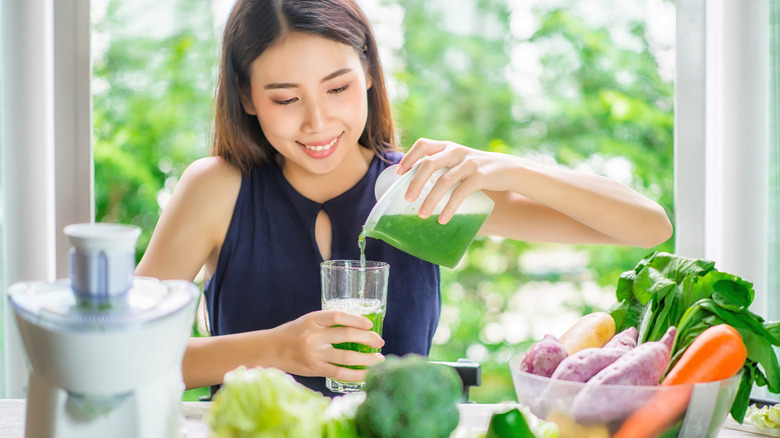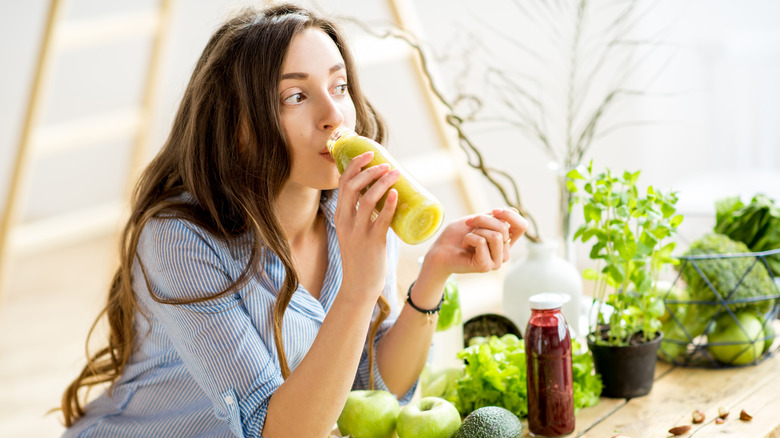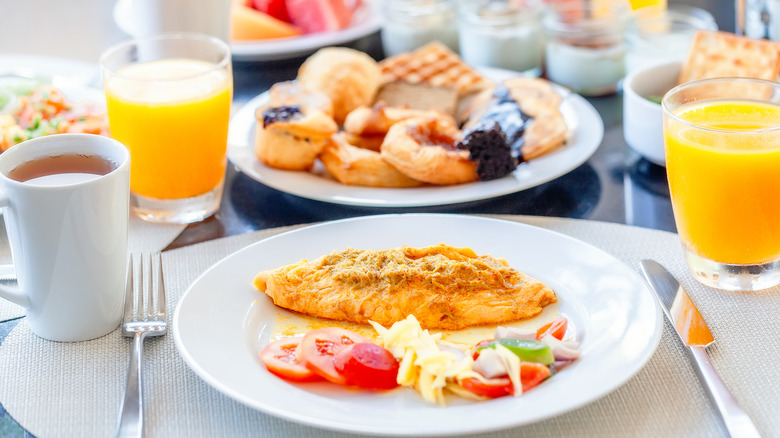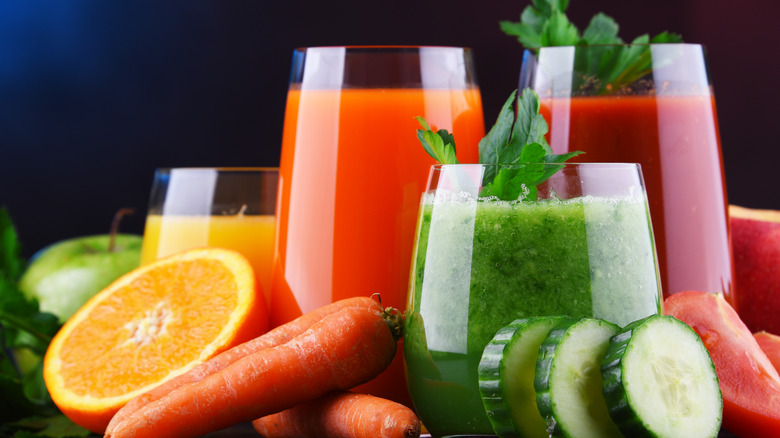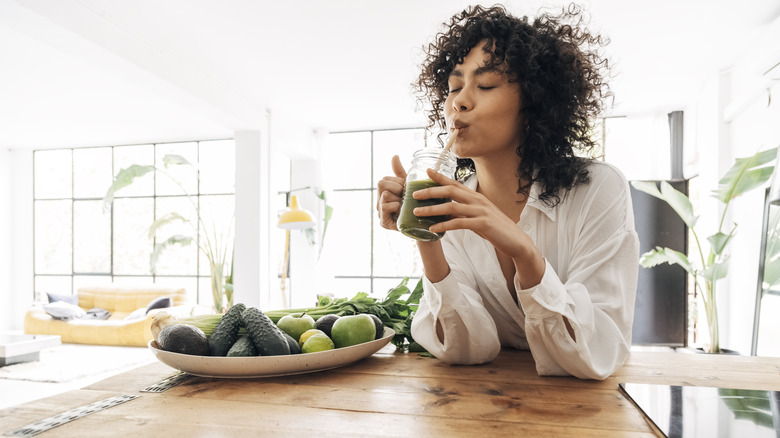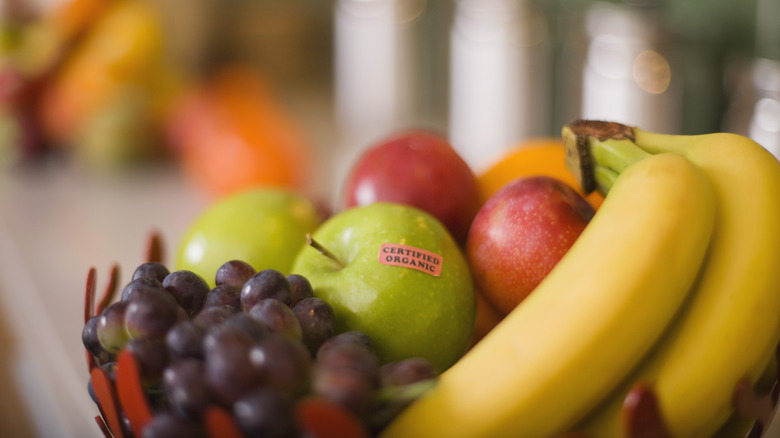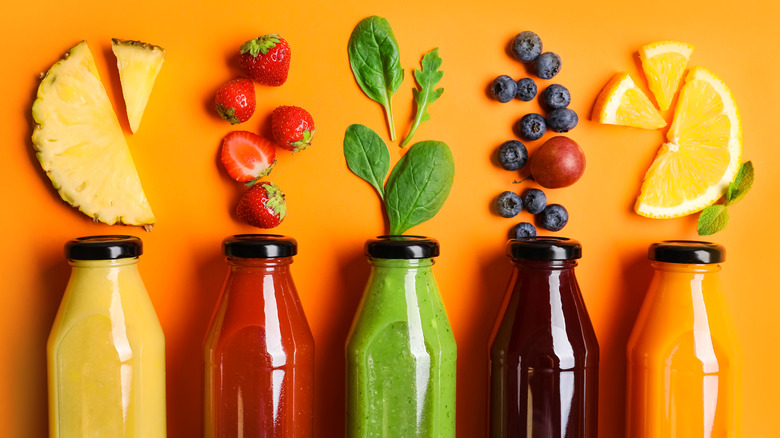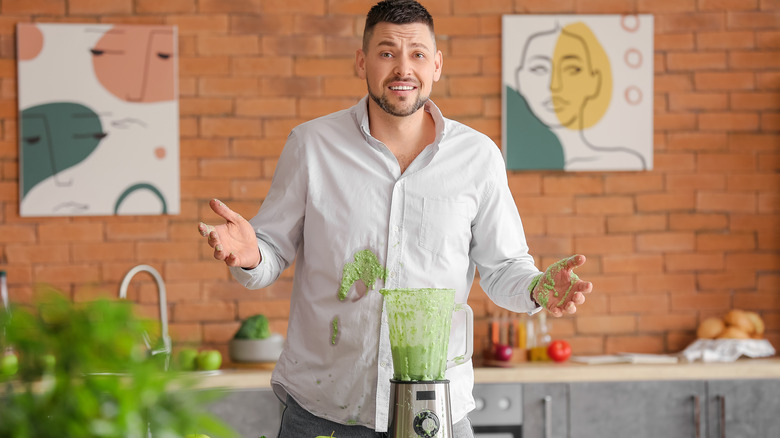13 Mistakes You're Probably Making With Homemade Juice
If you're looking for a way to increase your nutrient intake and boost your overall health, juicing can be a good way to help you achieve those goals. As the name suggests, juicing extracts the juice from different fruits and vegetables, creating a drinkable liquid. Depending on the specific food item, the juice may be removed by squeezing, pressing, or grinding. While juicing may not be healthier than eating whole fruits and vegetables, it can help you increase your overall fruit and vegetable intake. Juicing can also offer a range of positive implications for your health.
Consuming juice allows the body to absorb the various nutrients from fruits and vegetables. Unlike when you eat whole fruits and vegetables, you don't have to first digest the fiber to be able to absorb these nutrients. More research is needed, but it appears that juicing may also support the cardiovascular system in lowering blood pressure by introducing more nitric oxide into the blood. Whether you've been juicing for several years or have just started trying different recipes, there are a few common mistakes you might be making. Avoiding these things can help ensure that the juice you enjoy is as healthy and delicious as possible.
1. Not juicing vegetables too
If you've only been juicing fruits, it is time to add some vegetables to your creations. While fruit is undoubtedly delicious and flavorful, it shouldn't be the only ingredient in your juice if your goal is to create a healthy drink. One of the main reasons that fruit is so sweet and delicious is that it has a higher sugar content. It's natural sugar, but it is still sugar. If you add too much, it could increase your blood sugar levels.
When you balance the fruit in your juicing recipes with some vegetables, it will help keep the overall sugar content of the smoothie at a lower level. Moreover, you'll benefit from all the nutrients the vegetables deliver. For example, when you juice kale, you're giving your body antioxidants and vitamins A, C, and K. Adding carrots to your recipe provides biotin, potassium, vitamin A, and various antioxidants. Spinach is another popular vegetable for juicing. It is an excellent source of vitamins A and C, nitrates, and antioxidants. When developing recipes for juicing, aim to make more than half of your ingredients vegetables. This should provide you with a good balance of nutrients and enough fruit to still make the juice sweet and enjoyable.
2. Not using organic fruits and vegetables
Another tip to help you maximize the health benefits of juicing is to use organic fruits and vegetables instead of their conventional counterparts. You might not notice a taste difference between organic and non-organic produce, but there is a health difference. By definition, organic fruits and vegetables are grown without the use of any chemicals or pesticides. However, pesticides and chemicals are commonly used when growing other fruits and vegetables.
Even if you wash your produce, traces of these potentially harmful chemicals will still be on the different fruits and vegetables. The pesticides are often stored within the fibers of different foods, so they will not be fully removed by washing. When you then juice these items, the chemicals and pesticides will be mixed into the beverage you drink. Suppose you start with organic or even homegrown produce. In that case, you can juice your favorite fruits and vegetables without worrying about any chemicals or pesticides getting mixed in with your delicious juice.
3. Not washing the fruits or vegetables you're juicing
You always want to wash fruits and vegetables before juicing them. If you are unable to buy organic produce, washing will help remove as many pesticides and chemicals as possible. But removing pesticides isn't the only reason to wash your produce. The surfaces of fruits and vegetables can also be covered with various bacteria or germs. Think about all the places these items have been during the production process and how many different sets of hands may have come into contact with them before they made it into your grocery cart.
According to the FDA, you should follow a few steps to ensure that your fruits and vegetables are properly washed. First, you should always start with clean hands. Then, inspect each item for bruises, and cut these bad spots off your produce before using them. Hold each fruit or vegetable under running water and gently rub all its surfaces with your fingers. When cleaning firmer fruits and vegetables, such as carrots, cucumbers, or cantaloupes, scrub them using a vegetable brush.
Before juicing or eating fruits and vegetables, it is also recommended to dry them using a paper towel or a clean dish towel. Doing so will help remove bacteria lingering on the surface. Even if you'll be peeling the skin off fruits and vegetables before juicing them, it is still important to wash each item first. Otherwise, you'll simply be moving the germs from the skin to the peeler, which will be transferred right back onto the fruit or vegetable.
4. Not using a cold press juicer
There are a few different types of juicers to choose from. Two of the most common are centrifugal juicers and cold press juicers. Centrifugal juicers extract juice from fruits and vegetables by chopping and shredding them up into tiny pieces with their sharp blades. After the liquid is released, it is pulled to the end of the cutting disc through centrifugal force and separated from the pulp. This process requires a lot of heat to work properly. Conversely, cold press juicers work without needing any heat. They crush fruits and vegetables to extract their juices.
If you've been using a centrifugal juicer, now may be the time to switch to a cold press model. The process used by cold press juicers is able to extract more juice from each fruit or vegetable. Plus, the fluid they remove contains more minerals and vitamins than a centrifugal juicer can extract. More enzymes are preserved when using a cold press juicer, which can result in a tastier and healthier finished product.
5. Assuming homemade juice can be a meal replacement
As we've already explained, juicing can deliver a lot of health benefits. However, the juice you make should not be used as a meal replacement. Juice is not thick and does not offer higher levels of fiber or protein. It is best used as an appetizer to a meal rather than to drink in place of a meal. Because our bodies digest juice so quickly, it can also have a negative impact on blood sugar levels if it is not enjoyed with something else.
If you are looking for something similar to juice that can serve as a meal replacement, consider trying green smoothies. When made with the right ingredients, a green smoothie can offer sufficient vitamins and nutrients to serve as a meal replacement. Green smoothies are made by blending — not juicing — fruits and vegetables. Therefore, you are consuming whole fruits and vegetables, not just the juice that is extracted from them. A green smoothie is much thicker than juice. It will be much more filling and help you make it to the next meal.
6. Drinking juice before eating other foods
It's probably not a great idea to use juice as a meal replacement. It is best to enjoy while eating something else or as a treat and not while your stomach is still empty. NDTV Food spoke to clinical nutritionist Rupali Datta about the different things you should avoid having on an empty stomach — and juice was one of them. Datta explained that when you drink your juice on an empty stomach, it might "put an extra load on the pancreas that [is] still waking up after long hours of rest."
While having some fresh vegetables and fruits early in the day might be fine, you might want to steer clear of those on the sweeter side. In the NDTV Food article, Datta made a good point stating that "sugar in the form of fructose in fruits can cause an overload on your liver," so it's best not to have sweet juice for breakfast. So, if you drink your juice after a meal, your stomach will probably have a higher fiber content. And more fiber means the digestion process will slow down, helping your body absorb more vitamins and minerals from other foods — or, in this case, juice — you consume.
7. Not experimenting with different recipes
There is nothing wrong with having a favorite juice recipe. However, if you're always making the same recipe, you're making a mistake. First, we don't know what we haven't tried. You won't see what you're missing out on if you never expand your horizons and try something new. You could find a new combination of fruits and vegetables that is even more delicious than your current favorite recipe.
Adding some variety can help make sure you don't get tired of drinking the same juice over and over. This could even cause you to give up on juicing altogether. If you continuously use the same green vegetables when making your juice, it could cause oxalic acid to build up in your body. Too much oxalic acid can negatively impact your kidneys. On the other hand, when you incorporate different greens, such as spinach, kale, chard, or mustard greens, into your smoothies over the course of several weeks, you'll be giving your body a more balanced assortment of vitamins and minerals. Fortunately, there are many different healthy juice recipes out there to try that will help you incorporate other greens into your tasty creations.
8. Drinking the juice too quickly
Freshly made juice can be quite delicious. Once you get a little taste of your flavorful creation, it can be hard to put the glass down. You may find yourself gulping the entire glass within a few seconds. However, even if the juice tastes really good, you don't want to drink it too quickly. Not only will it be gone before you get a chance to enjoy it, but you may also experience some bloating shortly after.
Kind of like when you eat too much too fast when you drink juice too quickly, "you swallow more air," as stated by Northwestern Medicine. Similarly, if you drink your juice — or any beverage for that matter — with a straw, that may also contribute to bloating. Registered dietitian Sheila Mulhern told Adventist HealthCare, when you take that first sip, it "introduces air into the gastrointestinal tract, which in turn can cause gas and bloating." Rather than sipping your juice through a straw or chugging it in a few seconds, try sitting down to sip and savor it over several minutes. The act of slowing down while you drink your juice can also help relax your mind and body, encouraging your stomach to properly digest the liquid and your tastebuds to thoroughly enjoy all the flavors your juice has to offer.
9. Letting the juice sit too long before drinking it
While you don't want to drink all of your juice within seconds of making it, you also don't want to let it sit for too long before you drink it. When you drink the juice within about 15 minutes of making it, it will have the greatest quantity of nutrients and antioxidants to offer your body. The air and the light in the room decrease the potency and effectiveness of the antioxidants and break down the nutrients so that they are less effective.
This can reduce some of the potential benefits for your health. So, work to find the right balance between chugging your juice and letting it sit untouched for several minutes or more when you complete other items on your to-do list. This also means that, when possible, you should try to make your juice fresh every morning rather than making it ahead of time. You'll receive the greatest benefits from all of the nutrients in the juice when you drink it the day it is made.
10. Adding too many sweet fruits to the juice
Balancing the ratio of fruits and vegetables when making juice is important for a delicious outcome. Similarly, it is also important to make sure that you aren't only adding in sweet fruit. These can cause the sugar content of the juice to skyrocket, negating the health benefits you're looking to achieve from drinking the juice in the first place. If you are trying to keep your sugar intake under control, it can be especially detrimental, causing you to surpass your daily goals or, at times, increase any cravings you may have for sugary foods.
When making juice, aim to use not more than one sugary fruit. This will help keep the sugar content under control. Examples of fruits with a higher sugar content include mango, cherry, grape, pear, fig, watermelon, and banana. Raspberries, papayas, strawberries, guava, and avocado all have less but should still be used in moderation when juicing.
11. Not storing your juice properly
Ideally, you should be making your juice fresh every time you want to enjoy it. Juicing fresh fruits and vegetables is a great way to get as many vitamins, minerals, and antioxidants as possible. However, we all live in the real world and know that stopping to make fresh juice every day isn't always going to be possible. So, consider making a large batch and storing it to enjoy for a few days.
Storing your juice properly can help maintain as many of its beneficial nutrients as possible. Never store juice in a plastic container or jar without a lid, as those don't typically offer a truly airtight seal. Exposing the juice to air over time causes it to oxidize and decrease the potency of the nutrients in the juice. Instead, use an airtight glass container to store juice. If possible, look for one that is darker rather than clear to minimize the juice's exposure to the light. It is also a good idea to store your juice in several smaller glass containers, such as mason jars, rather than one larger glass jug. The juice will stay fresher, and you won't be exposing future servings to the air before you drink them.
12. Not cleaning your juicer right away
With so much going on in daily life, time really is of the essence. After you've finished making and drinking juice, you likely have several other things on your to-do list. So, it may be tempting to leave your juicer in the sink and clean it later. However, you should not skip cleaning your juicer right away. When you let the juicer sit with all the skin, pulp, and juice residue from the fruits and vegetables you juiced, everything is going to get all hard and crusty. Once you return and are ready to clean it up, you'll have a much more difficult time scraping off all of the residues.
If you clean your juicer right away, none of the produce scraps will have had the opportunity to get hard or stuck in difficult-to-reach places. Instead, it should rinse away easily, significantly reducing your cleaning time. If you are in a rush and washing your juicer simply is not possible, you may want to consider taking a few seconds to rinse it out and leave it soaking in soap and warm water. When you're ready to clean it later, it will be much easier to get it ready to be used again.
13. Not taking other steps to fully benefit from healthy juices
If you're drinking juices for weight loss, to help your body detox, or to simply improve your overall health, you don't want to undo all of your hard work by letting other areas of your diet slip. A juice cleanse alone will not be able to deliver the maximum benefits you are searching for unless you are taking a few additional steps to address your overall health. In addition to drinking the healthy juice recipes you whip up, you should also consider improving your overall eating habits. Look to cook healthy, well-rounded meals that include grains, seeds, nuts, protein, vegetables, healthy fats and carbs, and fruit.
Keeping your body well-hydrated is also essential. We've all heard the bit about drinking a minimum of eight glasses of water per day, but the truth is everyone's water intake is unique. According to the National Council on Aging, how much water a person needs is "based on a number of factors such as age, activity level, diet, health, and any medications being taken." But, once you've figured out your perfect amount, drinking that amount consistently will help improve your skin's appearance, remove toxins from your body, and help regulate your bowel movements, among many other things (via WebMD).
